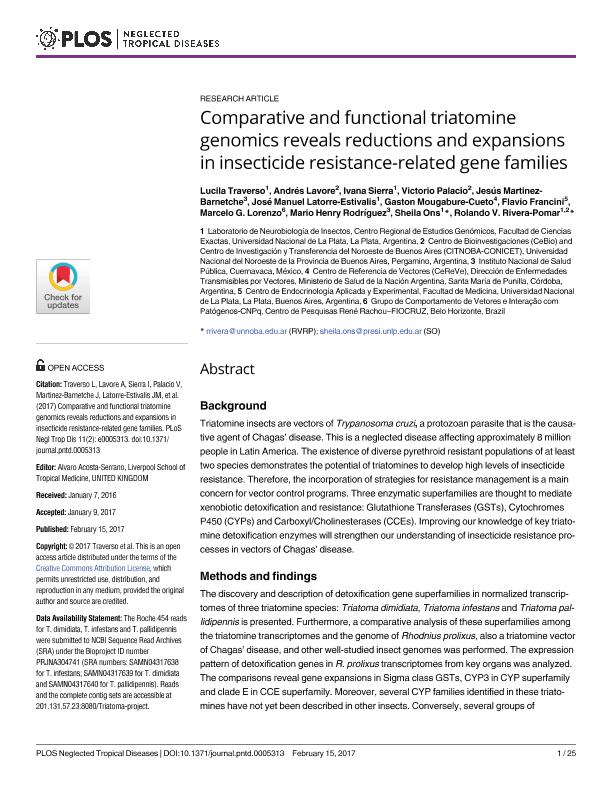Artículo
Comparative and functional triatomine genomics reveals reductions and expansions in insecticide resistance-related gene families
Traverso, Lucila María ; Lavore, Andres Esteban
; Lavore, Andres Esteban ; Sierra, Ivana Samanta
; Sierra, Ivana Samanta ; Palacio, Victorio Gabriel; Martinez Barnetche, Jesús; Latorre Estivalis, Jose Manuel
; Palacio, Victorio Gabriel; Martinez Barnetche, Jesús; Latorre Estivalis, Jose Manuel ; Mougabure Cueto, Gastón Adolfo
; Mougabure Cueto, Gastón Adolfo ; Francini, Flavio
; Francini, Flavio ; Lorenzo, Marcelo Gustavo
; Lorenzo, Marcelo Gustavo ; Rodríguez, Mario Henry; Ons, Sheila
; Rodríguez, Mario Henry; Ons, Sheila ; Rivera Pomar, Rolando
; Rivera Pomar, Rolando
 ; Lavore, Andres Esteban
; Lavore, Andres Esteban ; Sierra, Ivana Samanta
; Sierra, Ivana Samanta ; Palacio, Victorio Gabriel; Martinez Barnetche, Jesús; Latorre Estivalis, Jose Manuel
; Palacio, Victorio Gabriel; Martinez Barnetche, Jesús; Latorre Estivalis, Jose Manuel ; Mougabure Cueto, Gastón Adolfo
; Mougabure Cueto, Gastón Adolfo ; Francini, Flavio
; Francini, Flavio ; Lorenzo, Marcelo Gustavo
; Lorenzo, Marcelo Gustavo ; Rodríguez, Mario Henry; Ons, Sheila
; Rodríguez, Mario Henry; Ons, Sheila ; Rivera Pomar, Rolando
; Rivera Pomar, Rolando
Fecha de publicación:
02/2017
Editorial:
Public Library of Science
Revista:
Neglected Tropical Diseases
ISSN:
1935-2735
Idioma:
Inglés
Tipo de recurso:
Artículo publicado
Clasificación temática:
Resumen
Background: Triatomine insects are vectors of Trypanosoma cruzi, a protozoan parasite that is the causative agent of Chagas’ disease. This is a neglected disease affecting approximately 8 million people in Latin America. The existence of diverse pyrethroid resistant populations of at least two species demonstrates the potential of triatomines to develop high levels of insecticide resistance. Therefore, the incorporation of strategies for resistance management is a main concern for vector control programs. Three enzymatic superfamilies are thought to mediate xenobiotic detoxification and resistance: Glutathione Transferases (GSTs), Cytochromes P450 (CYPs) and Carboxyl/Cholinesterases (CCEs). Improving our knowledge of key triatomine detoxification enzymes will strengthen our understanding of insecticide resistance processes in vectors of Chagas’ disease. Methods and findings: The discovery and description of detoxification gene superfamilies in normalized transcriptomes of three triatomine species: Triatoma dimidiata, Triatoma infestans and Triatoma pallidipennis is presented. Furthermore, a comparative analysis of these superfamilies among the triatomine transcriptomes and the genome of Rhodnius prolixus, also a triatomine vector of Chagas’ disease, and other well-studied insect genomes was performed. The expression pattern of detoxification genes in R. prolixus transcriptomes from key organs was analyzed. The comparisons reveal gene expansions in Sigma class GSTs, CYP3 in CYP superfamily and clade E in CCE superfamily. Moreover, several CYP families identified in these triatomines have not yet been described in other insects. Conversely, several groups of insecticide resistance related enzymes within each enzyme superfamily are reduced or lacking in triatomines. Furthermore, our qRT-PCR results showed an increase in the expression of a CYP4 gene in a T. infestans population resistant to pyrethroids. These results could point to an involvement of metabolic detoxification mechanisms on the high levels of pyrethroid resistance detected in triatomines from the Gran Chaco ecoregion. Conclusions and significance: Our results help to elucidate the potential insecticide resistance mechanisms in vectors of Chagas’ disease and provide new relevant information for this field. This study shows that metabolic resistance might be a contributing cause of the high pyrethroid resistance observed in wild T. infestans populations from the Gran Chaco ecoregion, area in which although subjected to intense pyrethroid treatments, vector control has failed. This study opens new avenues for further functional studies on triatomine detoxification mechanisms.
Archivos asociados
Licencia
Identificadores
Colecciones
Articulos(CCT - CORDOBA)
Articulos de CTRO.CIENTIFICO TECNOL.CONICET - CORDOBA
Articulos de CTRO.CIENTIFICO TECNOL.CONICET - CORDOBA
Articulos(CCT - LA PLATA)
Articulos de CTRO.CIENTIFICO TECNOL.CONICET - LA PLATA
Articulos de CTRO.CIENTIFICO TECNOL.CONICET - LA PLATA
Citación
Traverso, Lucila María; Lavore, Andres Esteban; Sierra, Ivana Samanta; Palacio, Victorio Gabriel; Martinez Barnetche, Jesús; et al.; Comparative and functional triatomine genomics reveals reductions and expansions in insecticide resistance-related gene families; Public Library of Science; Neglected Tropical Diseases; 11; 2; 2-2017; 1-25
Compartir
Altmétricas



